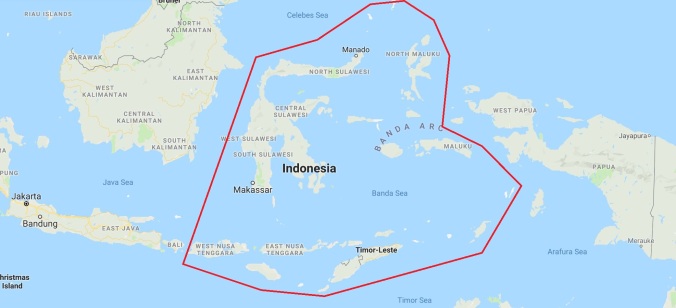In the previous fieldwork blog I wrote that we were about to leave on the boat to survey coral reefs around Ambon. So let me walk you through how our first week went.
Leaving Ambon took a bit more effort than expected, getting the necessary pre-departure paperwork signed off took 6 hours instead of 10 minutes, but we finally managed to leave late afternoon. We left under a rather gloomy sky, with grey clouds and scattered rain showers seeing us out of the bay instead of the bright sunshine we hoped for. But with an overnight boat trip ahead of us to get to the first sites, we could maybe wake up to blue skies.
That, unfortunately, was not meant to be…

Gloomy Ambon skies
When I mention “dive expedition in Indonesia”, most people tend not to imagine grey skies and unrelenting rain, but the lush tropics wouldn’t be quite as lush without lots and lots of rain! Throughout the week we had plenty of rain, sometimes so much we had to postpone dives because of the limited visibility at the surface: the boat driver needs to be able to see the divers at the surface to pick them up when surveys are done.
But we had come to Ambon to study coral reefs, so (mostly) undeterred by the rain, we hopped in and started our work! The first thing we noticed was a conspicuous lack of…coral. We started surveys in an area with a lot of human fishing activity, and it showed, big time. We did not hear any blasts while diving, but there was a lot of evidence of dynamite fishing. Entire reefs were reduced to rubble, some places even had large bomb craters, something I had never seen before. I dread to think about the size of the bomb and the immediate impacts of its blast. A lot of explosive power is required to leave a 40cm deep, 1.5m wide crater underwater!
It wasn’t all bad news though, some places were showing slow signs of recovery, which could mean they hadn’t been bombed for a while. There were still some large fish left, nowhere near as many as there should be, but I did spot a few large groupers and emperors, and even a few adult blacktip reef sharks. We saw encrusting algae and small coral slowly starting to take hold in some places, although they were still a long way from becoming a real coral reef again. I would estimate it could easily take another 50-100 years for these sites to become a fully functional reef, even if they were left in peace and there were no other impacts.
After a couple of days of rain and survey dives that made our hearts ache, the team’s morale (or at least mine) had seen better days. Luckily, two things happened: we moved on to sites that had less fishing pressure and the sun started shining!
This part of the trip brought home just how rich coral reefs can be if you just use them in a less destructive way. Sites with very high and diverse coral cover, big schools of fish, lots of invertebrates, funky critters, everything you could want in a dive. This time our only regret was that the tight schedule didn’t give us time to explore each site more thoroughly. Between trying to count and identify large schools of mixed fish species, processing eDNA samples and entering data, little time was left to do anything else than eat and prepare for the next dive. Not that I’m complaining though, being able to work on reefs like this is a privilege that never gets old.
We were also privileged to see some of Ambon’s funky critters. During quite a few dives we came across ghostpipefish (Solenostomus paradoxus and S. cyanopterus), a rare sight on standard coral reef surveys. Our invertebrate expert had his work cut out counting a variety of nudibranchs, shrimp, cowries, and anything in between. Even the algae crew got more fish than they bargained for when a giant frogfish (Antennarius commersoni) decided to swim by and say hello.
Despite some adverse weather and a slow start, we finished surveys within the planned time and arrived back in Ambon Bay two days ago. Our two days on land were put to good use, catching up on data entry and admin, meetings, and even catching a movie last night (Joker, pretty good actually). Tomorrow we leave at first light for a longer trip. We are headed to Halmahera, an area where precious little information exists on the health of coral reefs. If all goes according to plan, I should be able to write an update from Ternate in about 6 days!















